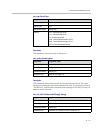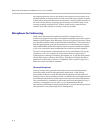
Design Guide for the Polycom SoundStructure C16, C12, C8, and SR12
B - 4
Directional microphones are most often used in conferencing systems due to
the rejection of the background noise, reduction of the reverberation, and the
rejection of the audio from the loudspeakers. Directional microphones also
increase the gain-before-feedback in sound reinforcement applications due to
the increased rejection of the loudspeaker signal when it is directed towards
the rear of the directional microphone.
As seen in the following figure, directional microphones typically have three
degrees of directionality - cardioid, super cardioid, and hypercardioid - each
with increasing directionality (that is, decreasing areas of pick-up). A
microphone with a cardioid pick up pattern will pick up signals within about
130 degrees of the front of the microphone, a supercardioid about 115 degrees,
and a hypercardioid about 105 degrees. From the following figure it is clear
that the supercardioid and hypercardioid microphones have a lobe in the rear
of the microphone that will pick up background noise more than the cardioid
microphone.
Shotgun microphones are even more directional that hypercardioid
microphones and attain this directionality by having the microphone element
in a tube with slots cut along the side. The signals from a narrow arrival angle
will reinforce constructively while those from off angle that travel farther will
cancel each other out, providing an extremely narrow pick up pattern.
Shotgun microphones are typically not used in conferencing due to the
extremely narrow pick-up pattern - should the local talker move out of the
narrow pick up pattern, their voice will be significantly attenuated. To the
remote listeners, it will sound like the local talker has faded out.
Noise Immunity
Cellular telephone systems often have transmit and receive frequencies in the
900 to 1800 MHz range. During normal operation of these cellular phones
there is regular communication with the closest cellular towers for status as
well as signaling incoming data and telephone calls. For some GSM style
phones this signaling occurs at the rate of one 576 µs pulse every 4.6 ms which
represents a 217 Hz signal. Often in conferencing applications, these cellular
telephones are placed on the conference table in close proximity to the local
microphones. Because these microphones often are not designed to be
immune to frequencies in the 900 MHz to 1800 MHz range, that the transmit
and receive signal can be easily coupled into the microphone where it is
rectified by microphone's electronics and combined with the local microphone


















